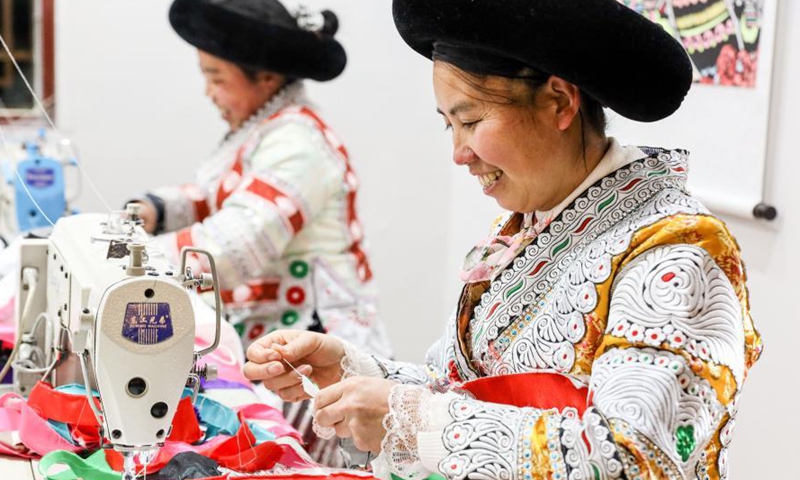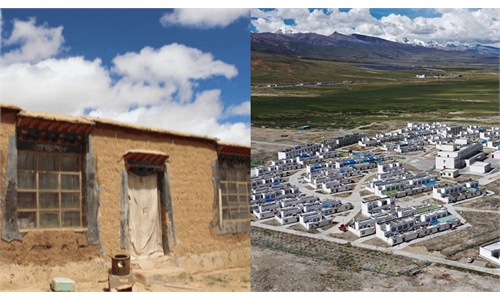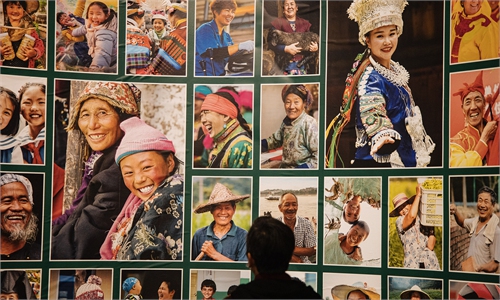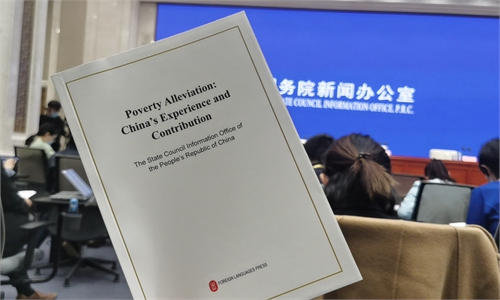China details key poverty reduction experience in white paper for global common prosperity

Villagers process garments at a poverty-alleviation workshop in Huawu Village, Xinren Miao Township, Qianxi County, Bijie City of southwest China's Guizhou Province, Feb. 3, 2021. Guizhou, which used to be a provincial-level region with the biggest population of poor people, has lifted more than 9 million people out of poverty since 2012. (Xinhua/Ou Dongqu)
China detailed its rich experience in poverty alleviation from the past decade with the issuance of a white paper on Tuesday to be shared and make contributions to global poverty reduction, which experts said fully demonstrates China's pursuit of common prosperity and its key factors in eradicating poverty, including the continuous and targeted poverty reduction plans implemented by the Communist Party of China.
China achieved victory in the largest-scale battle against poverty worldwide, as shown by 98.99 million rural residents, 832 impoverished counties and 128,000 poor villages all being lifted out of poverty, creating a miracle in history, Xu Lin, deputy head of the Publicity Department of the Communist Party of China (CPC) Central Committee and minister of the State Council Information Office, said at a press conference marking the launch of the White Paper on Poverty Alleviation on Tuesday.
The strategy of targeted poverty alleviation is China's strongest weapon in its final battle to secure victory against poverty, and a major innovation in the theory and practice of poverty reduction, said Xu.
Talking about the reasons why China was able to eliminate extreme poverty, Xu noted that the CPC has considered poverty alleviation as a key element of its governance and has brought together all the efforts of the Party and the country since the 18th CPC National Congress in 2012 to achieve the goal. Chinese leaders have also visited poverty-stricken regions on more than 50 occasions to learn about the real conditions of poor families.
The per capita disposable income of the rural poor increased from 6,079 yuan ($927) in 2013 to 12,588 yuan in 2020, increasing 11.6 percent every year on average, read the white paper.
The white paper also has an eye on the future, illustrating the country's plan for 2035-50 to achieve the full development of people and seeking the higher goal of realizing common prosperity, according to Xu.
In order to prevent local regions from returning to poverty, the country will set up monitoring systems and set a five-year period in the impoverished counties to stabilize the achievements of poverty alleviation, together with more than 30 supporting policies and more job opportunities, Wang Zhengpu, head of the national administration for rural vitalization, said at the press conference.

Picking their way out of poverty Fruit farmers pick mandarins in Hechi city, South China's Guangxi Zhuang Autonomous Region on Tuesday. In 2020, farms in Hechi harvested mandarins from 413,000 mu of land, which brought significant economic benefits to local farmers. Photo: Xinhua
China will also seek high-quality development in regions that used to be poverty-stricken. The country will improve the balanced allocation of public resources, and emphasize work in education, healthcare, elderly care as well as environmental management in rural areas, said Hong Tianyun, deputy director of the State Council Leading Group Office of Poverty Alleviation and Development. "The full vitalization of rural areas is a long-term task and calls for a joint battle from all departments and regions," he noted.
In terms of ethnic regions, from 2016 to 2020, in the five autonomous regions, including the Xinjiang Uygur Autonomous Region and the Tibet Autonomous Region, and three provinces with a large ethnic population, the poverty-stricken population dropped by 15.6 million.
"No single ethnic group can be left behind, this is the solemn promise of the Party," said Xia Gengsheng, vice minister of the State Council Leading Group Office of Poverty Reduction and Development. A third-party survey in late 2020 shows that more than 94 percent of residents are satisfied with the poverty reduction results in the eight ethnic regions.
In the future, supportive policies in ethnic regions will continue to be applied. Infrastructure construction will be completed and financial input will be increased to consolidate the fruits of poverty alleviation, Xia noted.
In the press conference, Han also explained the strict standards used for assessing poverty alleviation in China.
People can be identified as being out of poverty only if their annual income can reach 4,000 yuan by 2020, with basic food and clothing needs satisfied, and basic medical care, compulsory education and housing requirements secured. They must meet all these standards before they can apply for withdrawal, according to Hong.
Such standards are higher than the World Bank definition of extreme poverty and the target of the 2035 United Nations Sustainable Development Agenda, Hong stressed.



